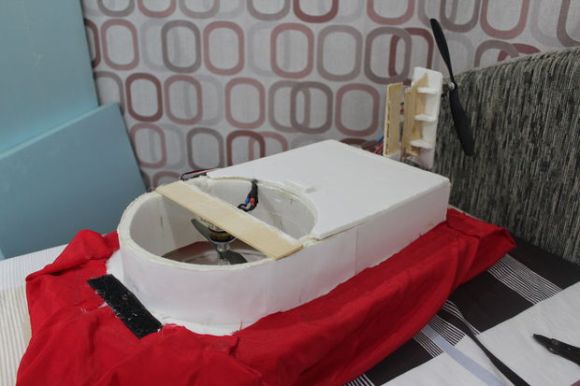
Looking for a fun little experiment in thrust vectoring? [Saral Tayal] has come up with what he thinks is the first style of thrust vectoring hovercraft.
A typical hovercraft uses one or two drives, one to hover, one to direct movement — or one for both, diverted to the two outputs. [Saral’s] toy hovercraft uses two, but unlike traditional designs, instead of having a rudder on the back to direct the airflow for steering, he steers the entire fan assembly. On a full size hovercraft, this could be a lot of fun.
It’s a pretty simple project that you could quite easily build on a weekend — if you’ve got RC parts kicking around, even easier! He’s using two brushless motors with ESCs, a 9g servo, and a small RC transmitter/receiver. The props come from a regular RC plane — just pick one suitable for the motor being used. Depending on what you have on hand, this project will be under $100 to build. The rest is mostly foam-board, balsa wood, and glue.
Check out the following video to see how it hovers!
Curious about thrust-vectoring? Check out what happens when you put it on a plane!















Cool build!
To the editors: When linking to an Instructable, can you prettyplease link to the entry including the ?ALLSTEPS flag? It makes me click less ;). Can’t imagine why anyone would not want to view all the steps at once.
Another thing… Gyroscopes. How do they work? Like magnets? I don’t care. All I know is if this method of steering was going to be used on a big (human capable size) craft, you are going to seriously battle with control. That propeller is going to want to stay in the orientation it was when it started up. A different solution might be to box your propeller and use louvres or similar. That way you encase your prop (safer) and you get do direct _all_ of your thrust.
But don’t listen to me – I’m just another fart on HaD that criticizes everything I see on here!
Quad-vectored hover-buggy! Almost as much fun as a life sized omniwheel go-kart!
The Omni-Wheel Go-Kart sounded like so much fun that I was compelled to Google it. I was not dissapointed: watch?v=ZSa3SPtoQrs
Looks like the same type of kart used in Silent Running.
is the rear motorneceary? i mean with a hole and enough thrust from the inner fan the rudder could guide the airstream
I have built numerous RC hovercrafts, and I would have to say yes to this. You can use one motor to do both, but it is sooo much better with two separate ones. If you use one, the craft almost always has to be moving to stay afloat, and you loose a ton of maneuverability. I also need to echo some of the other posters, cool idea but not new. Try building a centrifugal blower from styrene pieces for the lift fan assy that makes the air cushion! I should take pics of the ones I have built and get them up on my blog. Hovercrafts are seriously cool, if it weren’t for the fact that they take so much energy to run, they would be even cooler…
It looks more like a thrust vectoring bidet.
This hovercraft is full of eels.
Well, someone had to do it.
Golf Clap
I didn’t think that was what thrust vectoring was. I thought it was more along the lines of being able to move a duct to direct the thrust. I guess this does achieve that. I dunno I just figured it would be the one main prop with a duct controlled by a servo.
Agreed. I call that more “Gimballed Thrust”… It’s still thrust vectoring, but there are nuances….
hey i am the builder, and yes this is thrust vectoring, see flitetest’s foam viggen, or their thrust vectoring unit, they have basicly the same thing, but i did not copy, as their videos launced a couple of days after min
With the nose diving, it could use some more weight towards the back. Probably from having the motor up front. Pretty cool looking though!
+1
yes, my lighter battery was charging so, I put a charged battery for the video, which was twice the weight, so it hovers better than the video
Thrust vectoring on hovercrafts (both models and real) is not really a novel idea. I built a model eons ago, but can’t find the pictures of it anymore.
The mighty SR.N4 hovercrafts used on the now defunct hoverspeed connection from Calais to Dover had 4 props, each on a rotating pilon that could rotate through nearly 360 degrees. (This quick google image search pic shows the pylons rotated http://www.oldclassiccar.co.uk/classic-car-images/hovercraft.jpg)
Watching those machines coming in sideways and rotating onto the ramp in Calais was seriously impressive. I’m sad I never got to actually ride one.
Throw one (or two!) of these bad boys on there.